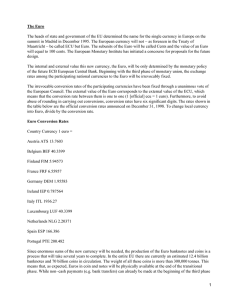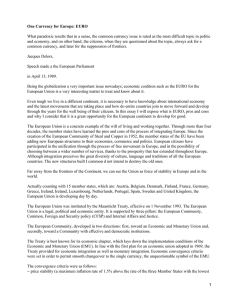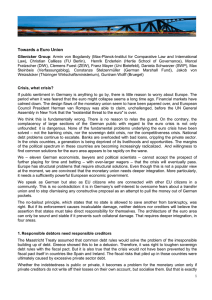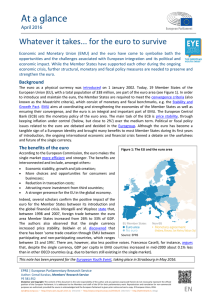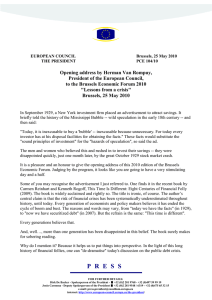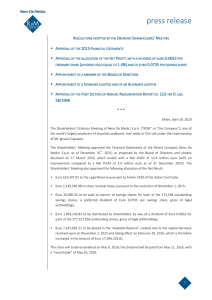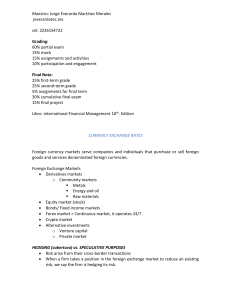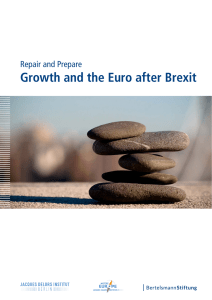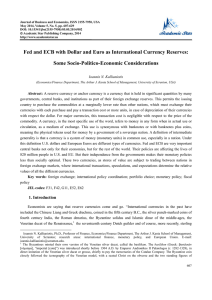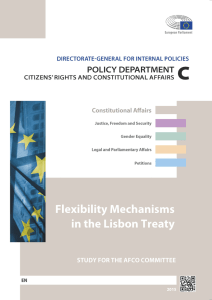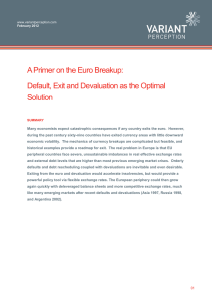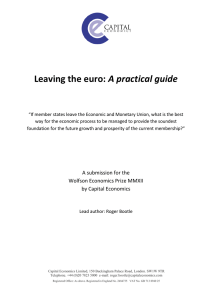UE (Unión Europea) # European Union
Anuncio
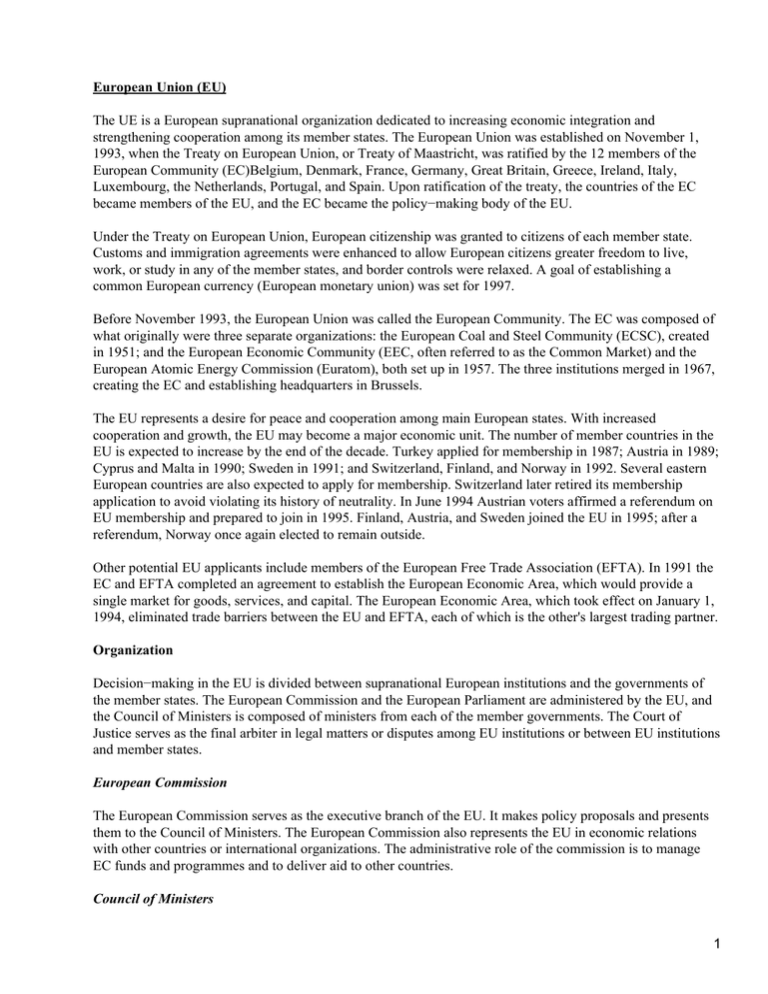
European Union (EU) The UE is a European supranational organization dedicated to increasing economic integration and strengthening cooperation among its member states. The European Union was established on November 1, 1993, when the Treaty on European Union, or Treaty of Maastricht, was ratified by the 12 members of the European Community (EC)Belgium, Denmark, France, Germany, Great Britain, Greece, Ireland, Italy, Luxembourg, the Netherlands, Portugal, and Spain. Upon ratification of the treaty, the countries of the EC became members of the EU, and the EC became the policy−making body of the EU. Under the Treaty on European Union, European citizenship was granted to citizens of each member state. Customs and immigration agreements were enhanced to allow European citizens greater freedom to live, work, or study in any of the member states, and border controls were relaxed. A goal of establishing a common European currency (European monetary union) was set for 1997. Before November 1993, the European Union was called the European Community. The EC was composed of what originally were three separate organizations: the European Coal and Steel Community (ECSC), created in 1951; and the European Economic Community (EEC, often referred to as the Common Market) and the European Atomic Energy Commission (Euratom), both set up in 1957. The three institutions merged in 1967, creating the EC and establishing headquarters in Brussels. The EU represents a desire for peace and cooperation among main European states. With increased cooperation and growth, the EU may become a major economic unit. The number of member countries in the EU is expected to increase by the end of the decade. Turkey applied for membership in 1987; Austria in 1989; Cyprus and Malta in 1990; Sweden in 1991; and Switzerland, Finland, and Norway in 1992. Several eastern European countries are also expected to apply for membership. Switzerland later retired its membership application to avoid violating its history of neutrality. In June 1994 Austrian voters affirmed a referendum on EU membership and prepared to join in 1995. Finland, Austria, and Sweden joined the EU in 1995; after a referendum, Norway once again elected to remain outside. Other potential EU applicants include members of the European Free Trade Association (EFTA). In 1991 the EC and EFTA completed an agreement to establish the European Economic Area, which would provide a single market for goods, services, and capital. The European Economic Area, which took effect on January 1, 1994, eliminated trade barriers between the EU and EFTA, each of which is the other's largest trading partner. Organization Decision−making in the EU is divided between supranational European institutions and the governments of the member states. The European Commission and the European Parliament are administered by the EU, and the Council of Ministers is composed of ministers from each of the member governments. The Court of Justice serves as the final arbiter in legal matters or disputes among EU institutions or between EU institutions and member states. European Commission The European Commission serves as the executive branch of the EU. It makes policy proposals and presents them to the Council of Ministers. The European Commission also represents the EU in economic relations with other countries or international organizations. The administrative role of the commission is to manage EC funds and programmes and to deliver aid to other countries. Council of Ministers 1 The Council of Ministers, the main law−making body of the EU, is composed of cabinet ministers from the member governments. The council is aided by the Committee of Permanent Representatives, which is comprised of the permanent representatives (or ambassadors) of each member state. European Council Summit meetings among the top leaders of the member states are called at least once every six months by the country holding the presidency of the Council of Ministers. This meeting of heads of state and government is called the European Council. The summits were instituted on a regular basis in 1975. The European Council became an official part of the EC structure in 1987. European Parliament The European Parliament is the only body of the EU whose members are directly elected by the citizens of its member states. Formerly only a consultative body, the parliament gained new influence under the Treaty on European Union. The main body meets in Strasbourg, though most of its committee work is done in Brussels and the secretariat is based in Luxembourg. The 567 seats are distributed based on the population of each member state. In 1994 Germany had the largest representation, with 99 seats. Individual committees of the European Parliament review legislation proposed by the European Commission. These committees often propose amendments to the legislation before submitting it to the Council of Ministers. The parliament may veto a proposal after it reaches the Council of Ministers if it disagrees with the council's position. The European Parliament also works with the Council of Ministers on the EU budget and can reject a budget plan if agreement cannot be reached within the council. Committees While the Treaty on European Union increased the political powers of the European Council, other bodies took on advisory roles similar to those once held by the parliament. The Economic and Social Committee is one of the most important of these bodies. Its 189 members are appointed to four−year terms by the Council of Members to represent employer and employee groups, as well as other interest groups. The committee has a strictly advisory role, but the Council of Ministers and the European Commission are obligated to consult the committee on many legislative issues. Another important group is the Committee of the Regions, created by the Treaty on European Union to bring the EU closer to its citizens and to give regional and local authorities a voice in government. The committee has 189 members that are allocated based on the population of each country. It has no legislative power, but must be consulted on matters relating to certain economic and social issues. Justice Court of The final arbiter in all matters of EU law is the Court of Justice. The court is composed of 13 judges who are appointed to six−year terms, with at least one judge from each member country. The court deals with disputes between member governments and EU institutions and among EU institutions, and with appeals against EC rulings or decisions. Courts of the member states often refer cases involving an unclear point of EU law to the Court of Justice. The court makes binding rulings on EU law to help guide the rulings of national courts. The rulings of the Court of Justice set legal precedents and become part of the legal framework of each member state. European Monetary System In March 1979 the European Monetary System (EMS) was established as a first step towards achieving an economic and monetary union.. The EMS was proposed to stabilize exchange rates and curb inflation by 2 limiting the margin of fluctuation for each member currency to a small deviation from a central rate. A common European Currency Unit (ECU) was introduced by which the central exchange rates could be set. The ECU was comprised of all the EU currencies, weighted according to the economic importance of each country. When any currency reached the limit of the margin of fluctuation, set at 2.25 per cent, the central banks of the respective countries were obliged to intervene by selling off the stronger currency and buying the weaker one. The EMS also required member governments to take appropriate economic policy steps to prevent continued deviation from the central rate. The EMS helped lower inflation rates in the EC and eased the economic shock of global currency fluctuations during the 1980s. However, its principal mechanism, the Exchange Rate Mechanism (ERM), collapsed in September 1992 under sustained attack by currency speculators, triggered by high German interest rates following reunification. Italy and Great Britain were forced out of the ERM. The European currency: EURO On January 1, 1999, eleven European countries replaced their national currencies and introduced a single European currency, the Euro. As of this date, the Euro is the official currency in the eleven participating countries. Bills and coins of the national currencies will remain in circulation as subdenominations of the Euro until January 1, 2002, when they will be exchanged against new Euro coins and bills. However, all inter−bank commerce and stock exchange trade is now denominated in the official currency On June 30, 1998 the European Central Bank (ECB), which will replace the current European Monetary Institute, was inaugurated. On December 31, 1998, the conversion rates between Euro and national currencies were irrevocably fixed (based on the bilateral exchange rates already established in May). Conversion rates have six significant digits. On January 1, 1999 Euro became the official currency in the eleven participating countries; the definition and execution of the single monetary policy in the Euro began and foreign exchange operations began to be carried out in Euros. New public debt will be issued in Euros; old public debt will be translated into Euros. Stocks and bonds will be quoted in Euros on all stock exchanges in the member area. National currencies will simply be denominations of the Euro, and continue to be used as a matter of convenience only until 2002. On January 1, 2002 the circulation of Euro banknotes and coins will start; this day is the same across EMU member countries. National currencies will be completely replaced by Euro in within six months after the introduction of Euro notes and coins. One Euro is equal to 100 cents or Euro−cents. (Each nation may call the sub−unit "cent" whatever they wish; so presumably there will be an euro−pfennig in Germany and an Euro−centime in France.) There will be eight different coins and seven different banknotes. With the creation of the single European currency, there will be a need for a new interbank reference index for the euro zone countries. Euribor (European interbank offering rate) will replace the national monetary indexes for the countries of the euro zone, beginning in 1999. The European Banking Federation will be responsible for the calculation and dissemination of this index The irrevocable conversion rates of the participating currencies have been fixed through a unanimous vote of the European Council. The external value of the euro corresponds to the external value of the ECU, which means that the conversion rate between them is one to one (1 [official] ecu = 1 euro). To change local currency into Euro, divide by the conversion rate. Euro Conversion Rates 3 Country Currency 1 euro = Austria ATS 13.7603 Belgium BEF 40.3399 Finland FIM 5.94573 France FRF 6.55957 Germany DEM 1.95583 Ireland IEP 0.787564 Italy ITL 1936.27 Luxembourg LUF 40.3399 Netherlands NLG 2.20371 Spain ESP 166.386 Portugal PTE 200.482 The dollar, the pound, and the yen all have symbols to denote their currency. A new symbol has been created for the Euro: a stylized "e", with two dashes instead of one in the middle. It is usually displayed in yellow colour on a blue background. 4
